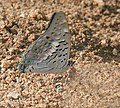Charaxes solon
| Black rajah | |
|---|---|

| |
| Charaxes solon | |

| |
| Charaxes solon △ | |
| Scientific classification | |
| Kingdom: | |
| Phylum: | |
| Class: | |
| Order: | |
| Family: | |
| Tribe: | |
| Genus: | |
| Species: | C. solon
|
| Binomial name | |
| Charaxes solon (Fabricius) 1793
| |
| Synonyms | |
| |
Charaxes solon, the black rajah, is a butterfly species found in tropical Asia. It belongs to the Charaxinae (rajahs and nawabs) in the brush-footed butterfly family (Nymphalidae).
Description

The black rajah is a medium-sized butterfly with a 70 to 80 mm wingspan. Above the butterfly is dark brownish-black with greenish or white discal bands across both the wings. The band is broken into spots towards the apex of the forewing. The hindwing has two similar-sized tails at veins 2 and 4. These tails are longer in the females and more pointed in the males.[1]
Its egg is transparent yellow and spherical in shape. It has longitudinal ridges. The egg has a dark red uneven band around its upper half. The caterpillar is dark green in colour with irregular rows of yellow tubercles. The caterpillar is cylindrical in shape and may have a round white blotch on the seventh segment. The head is outcurved and has horns and spines. The pupa is short, dark green and it has a lateral longitudinal line which is marbled white.[2]
Range
The butterfly is found in South Asia and South East Asia. It occurs in Sri Lanka, India, Myanmar, Indo China, Peninsular Malaysia, Singapore, Sumatra, Sulawesi, Philippines (Palawan, Sulu Archipelago). In India, the butterfly occurs in South India, and the Himalayas right from Kumaon, Sikkim, into Bhutan, through Assam and onto Myanmar. At least in South Asia, it is not rare.[3]
Ecology
The black rajah is generally a low-elevation butterfly and can be found at altitudes up to 1950 m (6500 feet) ASL.
The caterpillars generally feed on Fabaceae, such as tamarind Tamarindus indica.[2] At least on Borneo but probably elsewhere too, adults do generally not visit carrion or old fruit to drink liquids.[4]
Gallery
-
in Hyderabad, India.
-
in Hyderabad, India.

Footnotes
References
- Evans, W.H. (1932). The Identification of Indian Butterflies (2nd ed.). Mumbai, India: Bombay Natural History Society.
- Gaonkar, Harish (1996). Butterflies of the Western Ghats, India (including Sri Lanka) - A Biodiversity Assessment of a Threatened Mountain System. Bangalore, India: Centre for Ecological Sciences.
- Gay, Thomas; Kehimkar, Isaac David; Punetha, Jagdish Chandra (1992). Common Butterflies of India. Nature Guides. Bombay, India: World Wide Fund for Nature-India by Oxford University Press. ISBN 978-0195631647.
- Hamer, K.C.; Hill, J.K.; Benedick, S.; Mustaffa, N.; Chey, V.K. & Maryati, M. (2006): Diversity and ecology of carrion- and fruit-feeding butterflies in Bornean rain forest. Journal of Tropical Ecology 22: 25–33. doi:10.1017/S0266467405002750 (HTML abstract)
- Haribal, Meena (1992). The Butterflies of Sikkim Himalaya and Their Natural History. Gangtok, Sikkim, India: Sikkim Nature Conservation Foundation.
- Kunte, Krushnamegh (2000). Butterflies of Peninsular India. India, A Lifescape. Hyderabad, India: Universities Press. ISBN 978-8173713545.
- Savela, Markku (2007): Markku Savela's Lepidoptera and some other life forms: Charaxes. Version of 2007-JUN-05. Retrieved 2007-SEP-08.
- Wynter-Blyth, Mark Alexander (1957). Butterflies of the Indian Region. Bombay, India: Bombay Natural History Society. ISBN 978-8170192329.





![Black rajah resting on Pongamia pinnata trunk in Mumbai at MAhim Nature Park [1] by MMRDA](http://upload.wikimedia.org/wikipedia/commons/thumb/b/ba/Charaxes_solon_at_MNP.jpg/120px-Charaxes_solon_at_MNP.jpg)